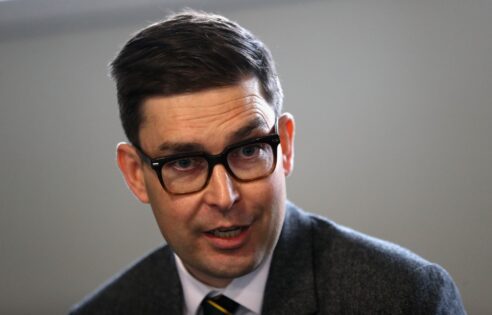The Saturday round of The Open Championship at Royal Portrush will feature altered tee times to make way for a scheduled band parade in the town that evening. As the final groups complete the penultimate round, a large crowd is expected, adding to the bustling atmosphere in the town centre as fans leave the course. But what’s the reason for this adjustment? It’s rooted in Ireland’s rich and complex history, which dates back to 1534, and the R&A’s inability to change the traditional parade schedule.
Yes, you read that right. The Portrush Sons of Ulster’s parade on Saturday evening, featuring over 60 bands and 2,000 participants, is set to coincide with the exodus of around 50,000 golf fans from the course. It will begin on July 19th at 8:15 pm. Despite reports that the R&A offered £20,000 ($26k) to postpone the event, the parade will go ahead as planned and will follow a route through Portrush’s main streets, concluding at 10:30 pm. The parade route will start and end at the fire station car park, passing through various streets in Portrush, including Eglington Street, Kerr Street, Lower and Upper Main Street, Causeway Street, and Victoria Street, in a loop.
Informing about the same, R&A’s chief executive stated, “We’re making a slight tweak to Saturday tee times – nothing major, 15 minutes or so earlier – but the weather can play a big role so it’s hard to be specific about finishing times.” But what’s the history behind this event that even R&A had to reschedule?
The story begins in 1534, when Henry VIII’s frustration with his wife Catherine of Aragon’s failure to produce a male heir led him to seek a divorce. When the Pope refused, Henry broke away from Rome, establishing the Church of England and declaring himself its head. This marked the start of the English Reformation, spreading Protestantism throughout Great Britain and laying the groundwork for future conflicts in Ireland.
In the 17th century, the Plantation of Ulster brought English and Scottish settlers to northeast Ireland, displacing the native Catholic population and sparking tensions that would escalate into violent confrontations. A pivotal moment came in 1690, when William of Orange defeated Catholic King James II at the Battle of the Boyne, cementing Protestant rule in Ireland for centuries to come.
The 20th century saw significant developments, starting with the Anglo-Irish Treaty of 1921, which established the Irish Free State and granted Ireland greater autonomy from British rule. However, the partition of Ireland left six northern counties, predominantly Protestant, as part of the UK, creating Northern Ireland. This division emerged as a potential source of conflict, which erupted in the 1960s when Catholics in Northern Ireland demanded equal rights, sparking the Troubles – a period of intense sectarian violence.
The governing body of the Open Championship is so worried about a parade that they reportedly offered £20,000 to the Portrush Sons of Ulster to postpone.
The group declined.
So what’s going on here? Let’s dive in: https://t.co/3TWEBY6J2a pic.twitter.com/p28q9t33y8
— Golf Digest (@GolfDigest) July 17, 2025
The annual Orange Walks, which began in 1796, reflect the ongoing tension between the two communities. These parades, organized by loyalist groups like the Orange Order, commemorate Protestant victories and take place from April to August each year. While many events pass peacefully, they can provoke strong reactions from the Catholic community. The Good Friday Agreement of 1998 marked a turning point, establishing a framework for peace and cooperation, yet the legacy of historical divisions continues to influence contemporary issues.
So, couldn’t it be held sometime else? The simple answer is “no.” A look at their Facebook page shows that for the past five years, they have consistently held their march shortly after the July 12 national marches, which commemorate the Battle of the Boyne. So, that’s the kind of history that’s going to impact The Open Championship this Saturday; however, this is not the only change affecting The Open at Royal Portrush.
Another “disappointing” change at The Open could also slow the pace of play
The R&A has introduced a change in its bunker raking policy for the 2025 Open Championship. Unlike previous years, when a team of dedicated bunker rakers from the British and International Golf Greenkeepers Association (BIGGA) maintained the course, this year the R&A has opted for a different approach.
Instead of dedicated rakers, players’ caddies will be responsible for tidying up bunkers after shots, with rakes left in the sand. This decision has raised concerns about potential slow play, given the large field and one-tee start. Andrew Darbon, a representative from the R&A, didn’t elaborate on the impact or reasoning behind the change, simply stating that it’s “I think this week we’ve got the caddies raking the bunkers. It’s a change for us but we think a good one” and citing “a number of factors” for the decision.
However, not everyone is convinced. PGA Tour pro Billy Horschel took to X to express his disappointment, saying that the absence of designated bunker rakers is “No designated bunker rakers this week is such a disappointment. I know the caddies love them, as well as the players. Very odd decision by the @TheOpen not to have them. @RandA.” Horschel is currently absent from the scene because of his injuries. So, what do you think of these two major changes at The Open?
The post Despite R&A’s $26K Offer, Year-1534 Tradition to Disrupt The Open 2025, Sources Claim appeared first on EssentiallySports.
